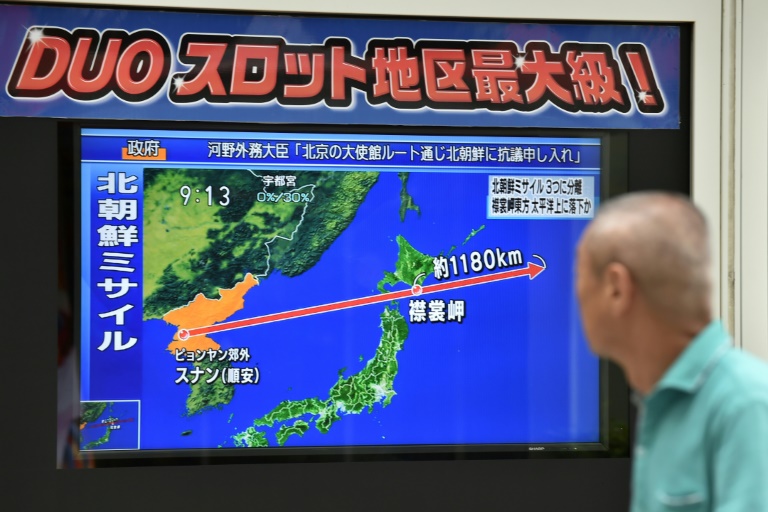Nuclear-armed North Korea fired a ballistic missile over Japan on Tuesday in a major escalation that triggered global alarm and a furious response from the government in Tokyo.
A visibly unsettled Japanese Prime Minister Shinzo Abe said it was an “unprecedented, serious and grave threat”, while the UN Security Council called an emergency meeting at Tokyo and Washington’s request.
Sirens blared out and text messages were fired off across northern Japan warning people in the missile’s flightpath to take cover.
Trains were delayed as passengers were urged to seek shelter inside stations.
“All lines are experiencing disruption,” said one sign on Sapporo’s metro system. “Reason: Ballistic missile launch.”
The last time a North Korean rocket overflew Japan was in 2009, when Pyongyang said it was satellite launch. Washington, Seoul and Tokyo believed it was a clandestine test of an intercontinental ballistic missile (ICBM).
Pyongyang last month carried out two overt ICBM tests that appeared to bring much of the US mainland within reach for the first time and heightened strains in the region.
At the time, US President Donald Trump issued an apocalyptic warning of raining “fire and fury” on the North, while Pyongyang threatened to fire a salvo of missiles towards the US territory of Guam.
South Korea said the latest missile was launched at around 2057 GMT Monday from Sunan, near Pyongyang and flew around 2,700 kilometres (1,700 miles) at a maximum altitude of around 550 kilometres.
Guam is about 3,500 kilometres from North Korea — although the missile was fired in an easterly direction and not towards the US outpost, home to 160,000 people and host to major military facilities.
Abe said the overflight was an “outrageous act” that “greatly damages regional peace and security”.
In a 40-minute telephone call with Trump, he said, the two allies had agreed to “further strengthen pressure against North Korea”.
– ‘Dead fish’ –
Any launch towards Guam would have to pass over Japan first and analysts said Tuesday’s overflight presents a major challenge to both Tokyo and Washington.
When it carried out its ICBM tests last month — which leader Kim Jong-Un described as a “gift” to “American bastards” — it fired them on lofted trajectories that avoided Japan.
Before 2009, the only time it had traversed Japanese airspace was in 1998, in what it also claimed it was a space launch. The US said it was a Taepodong-1 missile.
Pyongyang says it needs nuclear weapons to protect itself against the US, and the firing comes during the annual Ulchi Freedom Guardian South Korean-US joint military exercise, which the North always condemns as rehearsals for invasion.
“I don’t understand how this caught anyone by surprise,” Jeffrey Lewis of the armscontrolwonk website said on Twitter.
“It’s a smart move for the DPRK,” he added, using the initials of North Korea’s official name. “But what’s Trump going to do? Start a nuclear war over some dead fish?”
After Pyongyang appeared to postpone the Guam scheme, Trump told a rally in Phoenix that Kim was “starting to respect us”.
As a result, Cha Du-Hyeogn of the Asan Institute of Policy Studies in Seoul, told AFP: “It looked like North Korea backed off from a game of chicken.
“But Pyongyang is showing that is not how it is,” he said. “That it is not a chicken, it has not backed off and that Washington is the one who is bluffing with no concrete plan.”
– ‘Horrible day’ –
Japan has in the past vowed to shoot down North Korean missiles or rockets that threaten to hit its territory.
But it made no attempt to do so on Tuesday — when the missile flew over the country for two minutes — with defence minister Itsunori Onodera saying generals believed it posed no risk to the country.
“Today is really quite a horrible day for Japan,” security commentator Ankit Panda said on Twitter following Tuesday’s overflight.
“If North Korea assesses the costs of overflying Japan to be *anything* but intolerable, we’ll see more of these kinds of tests.”
AFP



